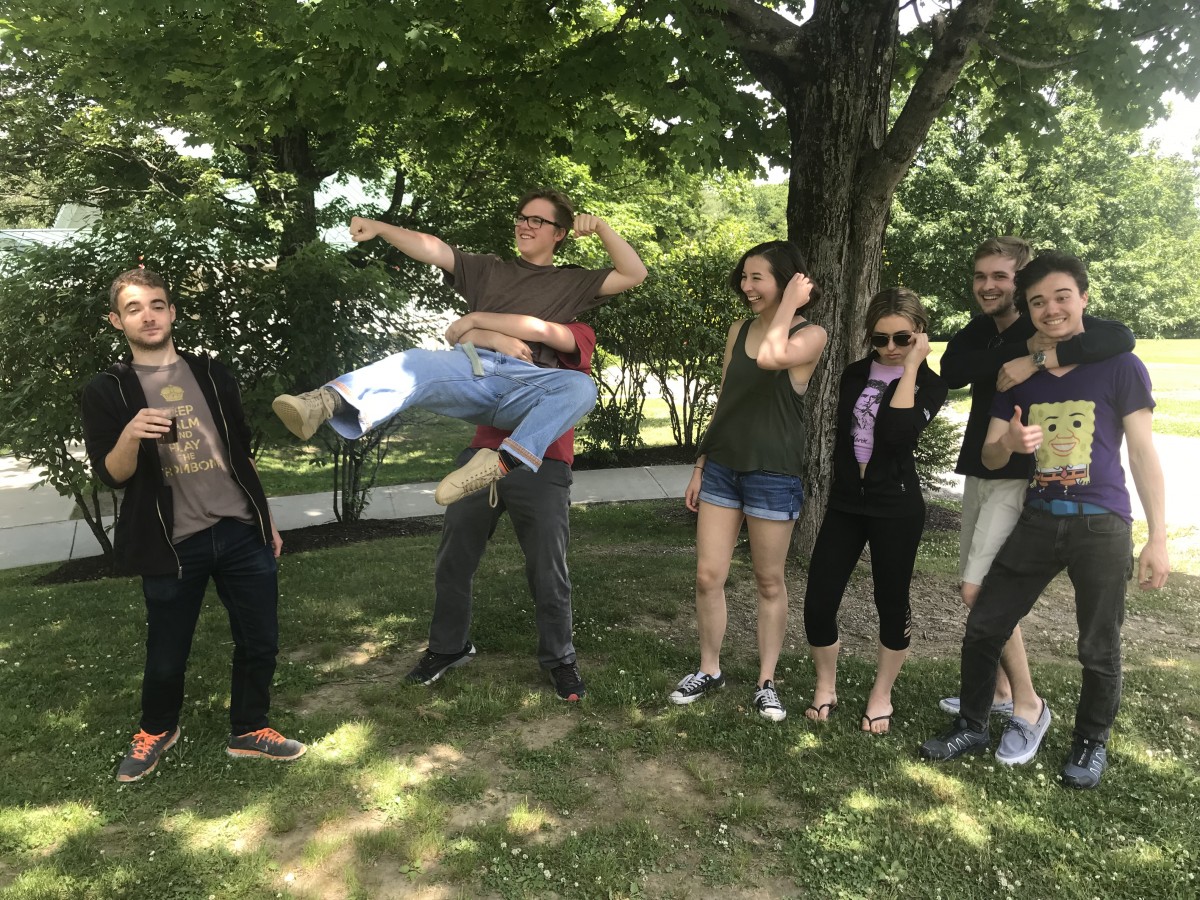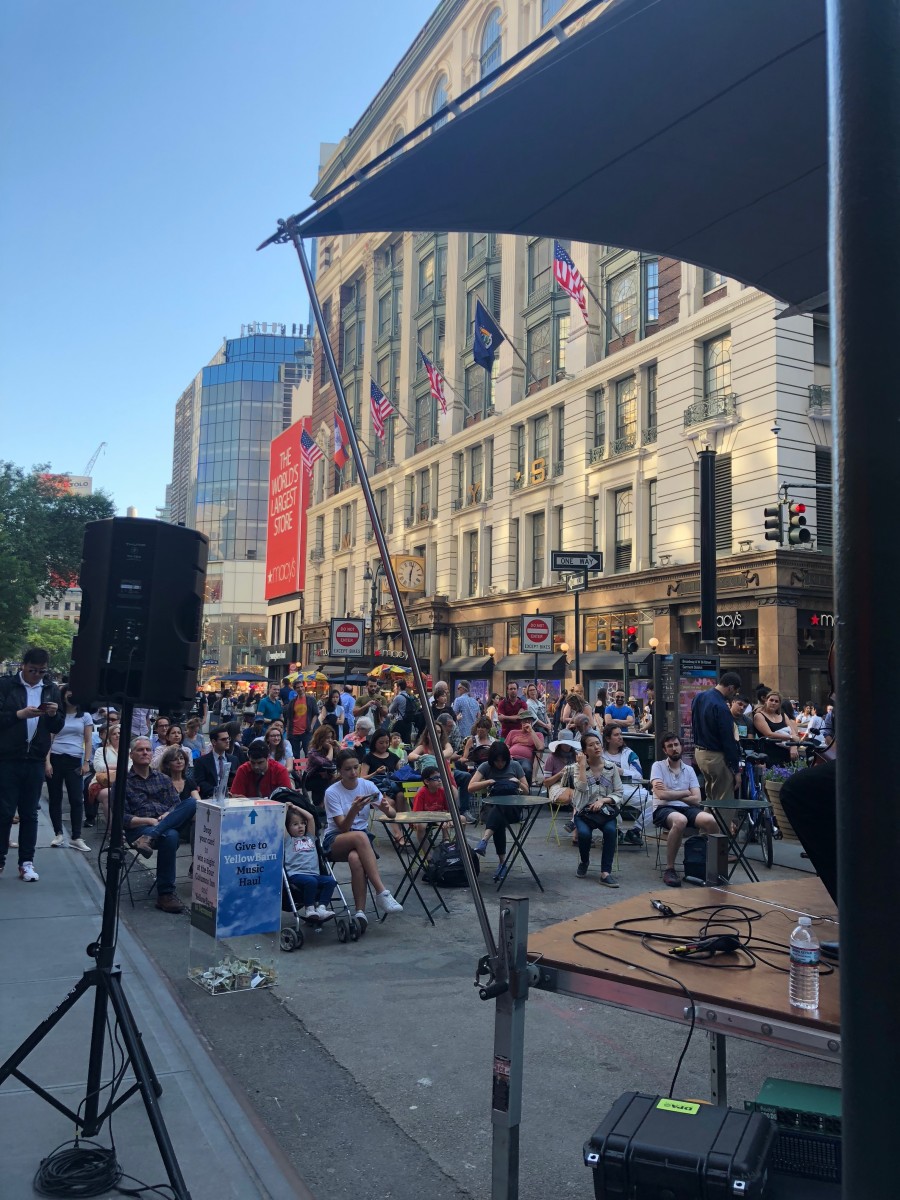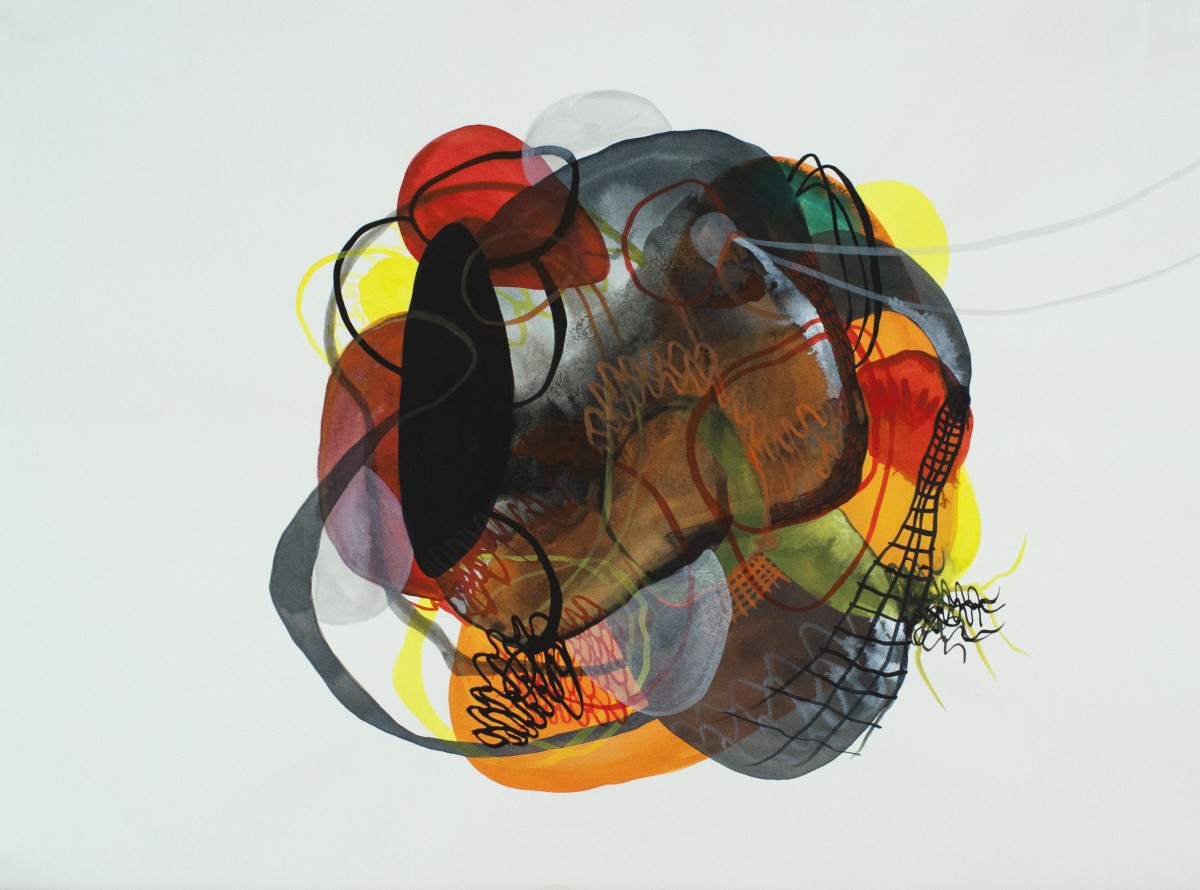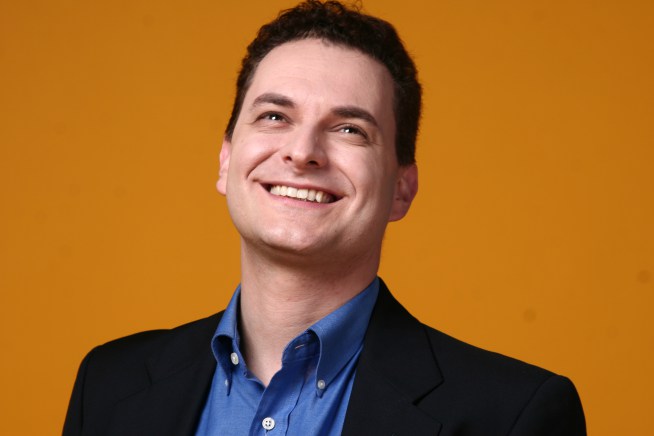In Their Own Words

2018 Young Artists Program composers, left to right:
Adam Karelin, Benjamin Champion, Theodore Haber, Hannah Ishizaki, Lauren Vandervelden, Matthew Pinder, Sequoyah Sugiyama
The Young Artists Program concert on June 17, 2018 features seven world premiere performances of works by our YAP composers. Here is what they have to say about their work:
Theodore Haber (b.1999)
Entrances at Bay (2018)I often go to a place called Indian rock to clear my head when I am back home in Berkeley, California. It is a rock formation that has been in the Berkeley hills for hundreds of years. From the top, you can see all of the Bay Area. When I arrived back home after finishing my first year in college, I wanted to go there to reflect. Along with me, I had brought a book of manuscript paper. I decided, while watching the sun set over the Golden Gate Bridge, to start writing this piece. I knew that I wanted to explore the idea of a single line as the entire conceptual and sonic material for the piece, but where that line would go, and how it would develop, I was not yet sure. So, as I sat at the top of Indian rock, reflecting on my year, looking forward, both in time and physically at the setting sun, I wrote the first few iterations, or entrances, of the line. They were the entrances at bay.
Adam Karelin (b.2000)
System Preferences (2018)System Preferences is a collection of three pieces: Systema Naturæ, Systema Machina, and Systema Deus. Systema Deus was premiered and recorded in the summer of 2017 in Los Angeles, by members of the Sunset ChamberFest. The full System Preferences suite is being premiered this afternoon, by members of the Yellow Barn Young Artists Program.
The pieces call for a retuned violin and mutes for the strings and piano in order to repurpose the sound of the trio in painting a landscape that is technically familiar to the players and sonically unfamiliar to the audience. The three systems share germinal material but treat it distinctly. Both the timbral similarities and disparities of the three instruments are explored through the dramatic scope of the ensemble.
Hannah Ishizaki (b.2000)
Lyrids (2018)Lyrids was inspired by a yearly meteor shower called the Lyrids, which occurs in April and passes through the constellation Lyra. This piece follows the emotions of an observer from the anticipation of the astronomical event to its passing and the subsequent stillness. Lyrids begins with a cello solo that represents the observer’s watchful hope, which is then passed to violin and then viola. The expectation is broken by punctuated piano that reflects the bursts of adrenalin upon viewing the first meteors in the sky, leading into the full meteor shower. The calm of dawn then comes at the end, but the feeling of anticipation for the next night’s meteor shower still remains.
Sequoyah Sugiyama (b.1997)
Variations (2018)Variations for piano quintet is my first foray into the world of integral serialism, a compositional technique wherein the constituent elements of the various parameters of music (i.e. pitch, rhythm, dynamics, etc.) are serialized, or placed into a strict order and realized almost exclusively in that order. Serialism was a divisive force in 20th century music, notorious for alienating concertgoers by prioritizing a seemingly academic rigor over conventionally pleasing aesthetics. But it is difficult to make generalizations about what the philosophical or artistic impetus for the emergence of serialism is because composers approached it in vastly different ways, and for sometimes contradicting reasons. My historical fascination with this approach to composition has evolved into a musical interest. In writing Variations, I set out to discover what I can learn from serial technique.
Lauren Vandervelden (b.1999)
Apprehension (2018)Before writing Apprehension, I knew my friend Anoush would be performing the clarinet part. This inspired me to craft a virtuosic clarinet part that would show off this quality in her playing. Beginning mysteriously, the clarinet line becomes more improvisatory, highlighted with percussive gestures. This cadenza-like opening allows the players musical freedom, enabling them to utilize liberty in the pacing of the introduction, pushing and pulling to create a sense of tension. The turbulence of the beginning erupts into a faster, more playful, yet still agitated section. My inspiration for the title came not from my analysis of my composition, but instead from my confusing the 12:00pm deadline given for the completion of my work and thinking it was 12:00am instead. Having missed the deadline, I was overwhelmed with panic and realized my anxiety resembled the turmoil of my composition, making Apprehension the obvious choice for my title.
Matthew Pinder (b.1998)
String Quartet (2018)This is the first movement of a four-movement string quartet. The movements are arranged in a slow-fast-slow-fast manner and this the first slow movement. One of my primary goals in composing this piece was to make sure every note had a definite place and purpose and to use as few notes as possible to convey as much as possible. I didn’t want to have dissonance just for dissonance’s sake or consonance just for consonance’s sake. What resulted was a movement consisting of long phrases with a slow melodic motion. It is my opinion that the long notes often hold tension and drama more effectively than fast notes and I tried to utilize this as much a possible in this piece.
The beginning is somewhat unusual. I have written a 29-measure duet between the first violin and the viola. This introduction is somewhat tonally ambiguous and the texture is thin because there are only two voices. When the whole quartet plays together for the first time, at measure 30, the warmth of a D-major chord is a polar opposite to what came before it. Throughout the rest of the piece I explore many different tonalities and textures while keeping the melodic motion relatively slow.
Benjamin Champion (b.2000)
Turtle Sphere (2018)Waiting for things to happen is one of my favorite activities. I imagine that sea turtles are the grand masters of waiting. I like to think that this piece waits for things to happen, in the same way that I imagine sea turtles do. I wrote this piece in a “non-discriminatory” way, by which I mean I sat in front of a piece of paper without preconception and wrote as ideas occurred to me. My only objective was to fill each page with an idea or a shape and then wait, not only for the next idea to come, but for the eventual textual arc holding all of the events together to reveal itself.
More works by these young composers can be heard on Thursday, June 28 and Friday, June 29 at The Big Barn.
Music No Boundaries: NYC 2018

MUSIC NO BOUNDARIES: NYC
May 24-26, 2018
Yellow Barn Music Haul's second annual trip to NYC spanned three days of performances in Manhattan, Brooklyn, and Queens with 34 musicians performing on street corners, in neighborhood plazas, and at city parks.
Titled “Music No Boundaries: New York City”, Seth Knopp’s programming included an evening performance dedicated to Bach’s cello suites, guitarist and composer Steven Mackey and percussionist Jason Treuting performing their original work Orpheus Unsung, Travis Laplante performing original works for solo saxophone, and many performances by Yellow Barn festival alumni.
See below for the full schedule of locations, programs, and performers.
MUSICIANS AND ENSEMBLES
Daniel Anastasio piano
Natasha Brofsky cello
Julia Bruskin cello
Lizzie Burns double bass
Elspeth Davis voice
Erika Dohi piano
Margaret Dyer viola
Madeleine Fayette cello
Gabriel Feldman piano
Magdalena Filipczak violin
Rosie Gallagher flute
Amanda Gookin cello
Melanie Henley Heyn voice
Brian Hong violin
Michael Katz cello
Travis Laplante saxophone
Jennifer Liu violin
Steven Mackey electric guitar
Merz Trio (Brigid Coleridge, violin; Julia Yang, cello; Lee Dionne, piano)
Bryan Park cello
Emely Phelps piano
Edvard Pogossian cello
Ian Rosenbaum percussion
Maren Rothfritz viola
Domenic Salerni violin
Daniel Schlosberg piano
Lucy Shelton voice
Max Tan violin
Cordelia Tapping voice
Jason Treuting drums
Andrea White flute
Aaron Wolff cello
Sound Engineer: Dev Ray
Stage Managers: Michael Bradley Cohen and John Zdojeski
PARTNERS
Yellow Barn is grateful to the following people and associations for making this tour possible:
Peter Arndtsen, Columbus Amsterdam BID
Astoria Park Alliance
Phil Gordon, Lincoln Square BID
Andrew Ronan, NYC DOT
Full Schedule
Thursday, May 24 | 4-6pm
Herald Square Plaza, on Broadway between 35th and 36th St., Manhattan
Johann Sebastian Bach (1685-1750) Suite No.1 in G Major, BWV 1007 (1720)
Julia Bruskin, Madeleine Fayette, Michael Katz, cellos
J.S. Bach Suite No.2 in D Minor, BWV 1008 (1720)
Edvard Pogossian, Aaron Wolff, Madeleine Fayette, cellos
J.S. Bach Suite No.3 in C Major, BWV 1009 (1720)
Edvard Pogossian, Natasha Brofsky, Julia Bruskin, cellos
J.S. Bach Suite No.4 in E-flat Major, BWV 1010 (1720)
Aaron Wolff, Julia Bruskin, Natasha Brofsky, Michael Katz, cellos
J.S. Bach Suite No.5 in C Minor, BWV 1011 (1720)
Edvard Pogossian, Michael Katz, Natasha Brofsky, Aaron Wolff, cellos
J.S. Bach Suite No.6 in D Major, BWV 1012 (1720)
Aaron Wolff, Natasha Brofsky, Madeleine Fayette, Julia Bruskin, cellos
"Open Mic" with Yellow Barn Musicians
Edwin Roxburgh (b.1937) Stardrift (1992)
Claude Debussy (1862-1918) Syrinx (1913)
Rosie Gallagher, flute
Elvis Costello (b.1954) Songs from “The Juliet Letters” (1993)
Elspeth Davis, voice; Brian Hong, Domenic Salerni, violins; Margaret Dyer, viola; Amanda Gookin, cello
Elliot Carter (1908-2012) Figment III (2007)
Lizzie Burns, double bass
Mark Applebaum (b.1967) Aphasia (2010)
Steve Reich (b.1936) Pieces of Wood (1973)
Ian Rosenbaum, percussion
Ursula Mamlok (1923-2016) Haiku Settings (1967)
Lucy Shelton, voice; Andrea White, flute
Cathy Berberian (1925-1983) Stripsody (1966)
Lucy Shelton, voice
Ludwig van Beethoven (1770-1827) Serenade in D Major, Op.8 (1795-97)
Magdalena Filipczak, violin; Maren Rothfritz, viola; Bryan Park, cello
Popular and Jazz Favorites
Cordelia Tapping, voice; Gabriel Feldman, piano
Franz Schubert (1797-1828) Gretchen am Spinnrade, arr. Franz Liszt (1811-1886)
Isaac Albéniz (1860-1909) from Iberia, Book I “Evocación” (1906)
Daniel Anastasio, piano
Kris Davis (b.1980) Trees and Grass on the Other Side of the Tracks (2018)
Erika Dohi, piano
Traditional American Folk Songs
Melanie Henley Heyn, voice
Travis Laplante (b.1982) Original works for solo saxophone
Travis Laplante, saxophone
Steven Mackey (b.1956) and Jason Treuting (b.1977) Orpheus Unsung (2015)
Steven Mackey, electric guitar; Jason Treuting, drums
"Open Mic" with Yellow Barn Musicians
Johann Sebastian Bach (1685-1750) Sonata No.1 in G Minor, BWV 1001 (1720)
Max Tan, violin
Popular and Jazz Favorites
Cordelia Tapping, voice; Gabriel Feldman, piano
Ludwig van Beethoven (1770-1827) Piano Trio in E-flat Major, Op.70 No.2
Merz Trio (Lee Dionne, piano; Brigid Coleridge, violin; Julia Yang, cello)
Donald Martino (1931-2005) from Fantasies and Impromptus (1981)
Alexander Scriabin (1872-1915) from 24 Preludes, Op.11 (1888-96)
Emely Phelps, piano
Henry Purcell (1659-1695) Sonata in A Minor, Z.804 (c.1680)
Jennifer Liu, Brian Hong, violins; Aaron Wolff, cello; Daniel Schlosberg, continuo
Steven Mackey (b.1956) and Jason Treuting (b.1977) Orpheus Unsung (2015)
Steven Mackey, electric guitar; Jason Treuting, drums
Travis Laplante (b.1982) Original works for solo saxophone
Travis Laplante, saxophone
Yellow Barn’s 2018 Summer Artwork

Katie Loesel, Plastiglomerate: Human Fossil, ink and watercolor, 22" x 30"; Courtesy the artist
Ornamentation and Articulation in Bach

The life of a performing musician who is simultaneously juggling the many responsibilities of a full-time professorship is hectic. Occasionally, I feel the need for a short escape to find protected time for my practicing and personal studies. When that retreat takes place at Yellow Barn—an idyllic place with studio space in quiet, spacious settings—one feels grateful. For this reason, it is exciting to imagine and look forward to my upcoming residency, when I will be able to concentrate on qualitative work and find some truly productive time!This residency will give me the chance to continue my studies of selected repertoire by J.S. Bach, in preparation for three upcoming solo recitals in China, the United States, and Italy. In addition, this moment of unique concentration on my work will be of great value for my upcoming CD project on the same subject. The focus of my residency is the study of choices of ornamentation and articulation, as well as the variety of applied possibilities, that the original text of Bach's selected works suggests based on historical evidence. In addition, I wish to use the uninterrupted time at my disposal to transcribe and study ornaments and articulations used by selected keyboard players who have left us recorded and vibrant interpretations of Bach. I am especially (but not solely) interested in the work of musicians who perform Bach on historical keyboards. Since I play Bach on the modern piano, the view of musicians who do not can only compliment and enrich what I feel more comfortable with. I am ready to accept the challenge!There is a downside to this idea, however, which has to do with certain traditions in the field of classical music. For instance, young jazz pianists routinely transcribe sound documents as a tool to better understand and study the styles of various performers. Unfortunately, this is not widespread among "classical" pianists, or, to avoid the use of that misunderstood word, pianists tackling other forms of art music. On the contrary, it is often frowned upon.This said, I have a very open-minded approach, and if the result of my work can help me (and others, when I present what I have discovered to other musicians) think of a few more possibilities to draw upon ornaments and articulations more freely (possibly, even on the spur of the moment from the available choices) and thus create some fresher interpretations, then I will be satisfied with the scope of the project.Naturally, there are helpful (albeit confusing) statements on ornamentation in several important historical sources (the major treatises of the Baroque period, for instance), but even those suggestions can be interpreted slightly differently among performers. Transcriptions may reveal differences in the interpretation of ornaments played by different musicians. Interpretations can vary between musicians even when their choices are based on historical evidence. The truth is that there are some possibilities and I am far more interested in the notion of the variety of these possibilities than of confining myself to accepting only one view (for instance, the first I envision). If there is one truth about the Baroque period, it is that performers were allowed a certain latitude with the text. The symbols—the notes, the pauses, the slurs, the staccatos, the ornaments—were meant as starting points. This does not mean that a performer should have a green light to do what he or she wishes at will. I hope to find a balance—a synthesis—between these radical points. I know that my journey at Yellow Barn will be a fascinating one!
Enrico will conclude his residency with a performance at Next Stage on Saturday, May 5th at 8pm. The concert concludes with an open discussion between musician and audience.
Extramusical Frameworks
Returning to Yellow Barn for a residency in February 2018, Yellow Barn alumni Brigid
Many of our projects provide our audiences with extramusical frameworks through which to listen, not to distract from the music-making, but as a reminder to listen closely, to hear a familiar piece differently. We are interested in what happens when the music that we play is brought into conversation with other artistic mediums—when our music is understood as fluid and dynamic, capable of interaction and discussion.
In the case of Permanent Red, our recital is framed and interwoven with Christopher Logue’s epic poem, War Music, of which Permanent Red is a smaller section. What Logue does so brilliantly in War Music is to take a story with which so many of us are familiar, the Iliad, and to re-tell it with an utterly free and contemporary use of language and verse. Using Homer as his guide, Logue relies both on our familiarity with the events of the Trojan War, as well as our knowledge of certain tropes that Homer returns to again and again in his verse. . .in order to transform the original Greek into singing modern speech, knowing that we will still recognize within it both the form and content of Homer’s masterpiece. Neoclassicism at its best.
Logue, then, is the inspiration both for our relationship with the recital format, and for our choice of repertoire within it. The musical works that we've chosen either share a similarly re-creative relationship with their predecessors, or are pieces that we've brought into the program in a somewhat irreverent fashion (often in single movements), thus allowing for a range of possible attitudes in which any given piece or movement might be performed.
Among the works responding to specific predecessors are Lutoslawski's Partita for Violin and Piano (a reimagining of a classic form), Szymanowski's The Fountain of Arethusa (after a Greek myth), and the first movement of Dmitri Smirnov's Violin Sonata No. 3, which transforms the melody from a Bach chorale "Es ist genug..." ("It is enough...") in a particularly gripping fashion. Among the shorter, more excerpted works on the program include 19th and 20th-century favorites of Kreisler, Strauss, Poulenc, and de Falla. How these smaller works are interwoven may range from simply expressing and amplifying the feeling a given textual moment, to an entirely humorous or ironic relationship with the text.
In all cases, the relationship of music and text is immediate and visceral. Every juxtaposition suggests a certain connection to be made. . .or equally to be rejected by the audience. Some of the neoclassically themed works may also be fun Easter eggs for musicians to recognize and identify, but altogether the program relies much more on connections that any listener can make on first hearing. In general, music and text alternate, but are also sometimes used together (with occasional speaking happening over the music or accompanied by passages of music).
Finally, the physical theater component of our work is less of an element in itself and more what emerges naturally from two musicians who are also delivering lines, inhabiting characters, and toggling between those roles of player and speaker on the turn of a dime. Often we will be speaking from staging configurations that should be familiar to anyone used to seeing musicians perform a recital, but that invite us, in that moment, to re-examine those physical configurations, restoring meaning to actions as simple as entering stage and taking a bow.
Artwork for Musical Offering

In January 2018, Yellow Barn's residency of J.S. Bach's Musical Offering, with interludes by Lei Liang's Garden Eight, toured from Putney to Symphony Space in New York, and to the Nasher Sculpture Center in Dallas. Yellow Barn designer John Kramer and Artistic Director Seth Knopp collaborated on graphic interpretation of the program.
John Kramer describes the image:
The central geometric form in the cover art is derived from the shape of a fountain in the gardens at Sanssouci, the summer palace of Frederick the Great. The superimposed image of a bare oak tree is rotated 12 times, aligning with the radial symmetry of the fountain’s design, and alluding to Bach’s branching polyphonic structures as well as the 12-pitch theme. Paths leading to the fountain from north, south, east, and west were converted to compass points in acknowledgement of the four-point directionality of Garden Eight.
